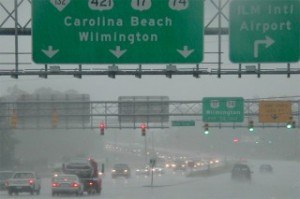Hurricanes are dynamic. Wind speeds change as the storm progresses and rainfall varies widely, creating tremendous uncertainty as the natural elements interact with man and man-made infrastructure.
Roads may close, traffic patterns may change, leading to travel delays that could impact lives and exacerbate public safety.
And yet researchers, policy makers and government officials have long relied on a static model to map hurricanes and chart evacuation zones, particularly when it comes to timing and decision-making.

Funded by a $3 million Science, Engineering and Education for Sustainability grant from the National Science Foundation, two University of Delaware faculty members are creating a fundamentally new approach to modeling hurricanes.
In a truly collaborative project, Rachel Davidson, professor of civil engineering, will work with co-principal investigators at other institutions to integrate a set of hurricane scenarios into an engineering model to support evacuation decisions.
The integrated model will allow the team to track how the hurricane moves and will create storm surge, wind speed and flooding maps that can be interchanged and overlapped. This dynamic new model would offer a more accurate picture of when and where evacuation orders should be issued, as well as the potential impact on viable evacuation routes and shelter options.
Tricia Wachtendorf, associate professor of sociology, will meanwhile examine the decisions people maker over the duration of a hurricane — and specifically, at what points during a storm — the information generated from Davidson’s model would be most useful to the “end users,” such as residents, emergency responders and government officials.
Together, Wachtendorf and Davidson, along with colleagues from the University of North Carolina-Chapel Hill, Cornell University, University of Oklahoma and Stony Brook University, hope to develop a new paradigm for understanding and managing how people make decisions as a storm progresses.
“What are the time markers that are important? When do we issue warnings?” asks Wachtendorf, associate director of the Disaster Research Center (DRC). “How much time do emergency responders need to review data before meeting with government officials, and when do they push that information out to the public?”
To better answer these questions, Wachtendorf anticipates that a hurricane during summer or fall 2014 will allow her and her graduate students the opportunity to conduct in-field observations, face-to-face interviews, and focus groups with emergency responders and decision makers.
“This project is a leap forward in understanding and improving management of evacuation and shelter for hurricanes,” says Davidson. “To the extent that can be done, we hope to reduce deaths, injuries and unnecessary expenses associated with ill-planned or ill-executed emergency response in the future.”
This work builds off the team’s previous hurricane evacuation work, as well as the DRC’s storied history in disaster research.
“A growing concern is that future hurricanes might be more devastating than our experience to date, due to growing coastal populations, limited road capacity and climate change,” says Davidson.
The novel modeling concepts under development may also apply to other natural hazards, including inland flooding, wildfires and ice storms.
“The results could have far-reaching effects on how society responds to natural hazards,” Davidson says.
Collaborating partners include the Federal Emergency Management Agency, the North Carolina Division of Emergency Management and the American Red Cross.
Source: University of Delaware
Was this article valuable?
Here are more articles you may enjoy.

 Asahi Sales Drop Worsens as Cyber Hack Disruption Lingers
Asahi Sales Drop Worsens as Cyber Hack Disruption Lingers  Losses Top $20 Billion in Asia Floods as Climate Risks Grow
Losses Top $20 Billion in Asia Floods as Climate Risks Grow  ‘Super Roofs’ Are Rewarding Insurers, Cat Bond Investors and Homeowners
‘Super Roofs’ Are Rewarding Insurers, Cat Bond Investors and Homeowners  Abbott Presses Congress for Shield Over Preemie Baby Formula Litigation That Could Cost It Billions
Abbott Presses Congress for Shield Over Preemie Baby Formula Litigation That Could Cost It Billions 